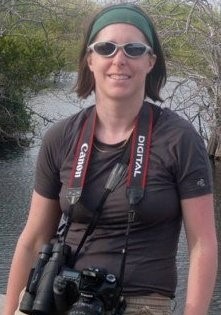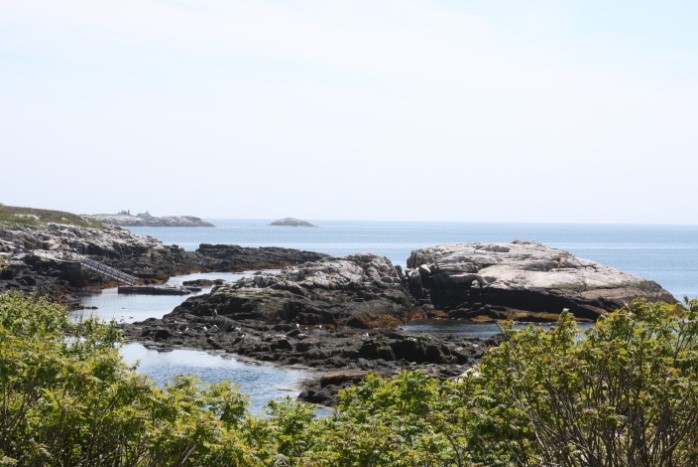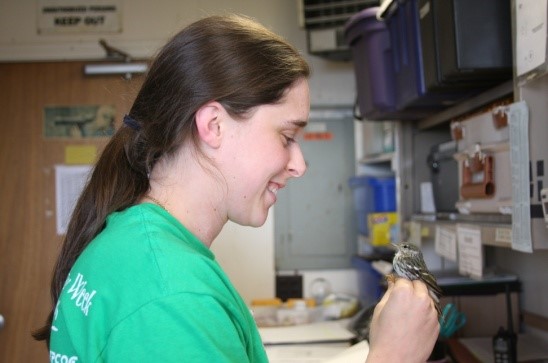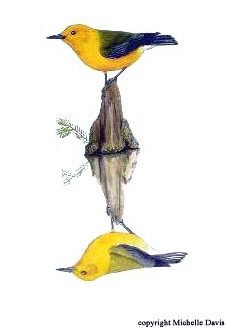| |
 |
Breeding Preparation & Physiological Adjustments of Nearctic-Neotropical Songbird Migrants during Spring Passage |
 The factors that influence population change in Nearctic-Neotropical migrants are not well understood largely because they are complicated by the interactions between stages of the annual cycle. My research focuses on the behavioral and physiological mechanisms that mediate transition between phases of the annual cycle, notably between spring migration and the breeding season. Migration is not only when birds travel between their wintering and breeding areas, but, vernal migration in particular, is also the part of the annual cycle when they must transition their physiology between the unique challenges of their migratory journey and those faced when breeding. Migratory songbirds are constrained not only by a short breeding season but also by a lengthy and arguably challenging journey prior to breeding. Physiological preparation for breeding (e.g. spermatogensis and folliculogenesis) requires time, and preparation must begin prior to arrival on the breeding grounds. Although some attention has been devoted to study of breeding preparation on the wintering grounds, it has yet to be fully investigated during vernal migration. The factors that influence population change in Nearctic-Neotropical migrants are not well understood largely because they are complicated by the interactions between stages of the annual cycle. My research focuses on the behavioral and physiological mechanisms that mediate transition between phases of the annual cycle, notably between spring migration and the breeding season. Migration is not only when birds travel between their wintering and breeding areas, but, vernal migration in particular, is also the part of the annual cycle when they must transition their physiology between the unique challenges of their migratory journey and those faced when breeding. Migratory songbirds are constrained not only by a short breeding season but also by a lengthy and arguably challenging journey prior to breeding. Physiological preparation for breeding (e.g. spermatogensis and folliculogenesis) requires time, and preparation must begin prior to arrival on the breeding grounds. Although some attention has been devoted to study of breeding preparation on the wintering grounds, it has yet to be fully investigated during vernal migration.
I am studying migrants on stopover at Johnson’s Bayou, Louisiana, and on Appledore Island, Maine, to determine whether or not migratory birds begin breeding preparation during migration, and if so, whether preparedness is adjusted as they approach their breeding destination. Preliminary work includes sampling Swainson’s Thrushes (Catharus ustulatus), Magnolia Warblers (Dendroica magnolia), and Northern Waterthrushes (Parkesia noveboracensis) for breeding hormones (plasma testosterone and estrogen). These factors are also being related to energetic condition in order to investigate possible physiological adjustments en route. Presumably individuals that are in better overall condition will be better able to prepare for breeding while still en route, whereas those struggling with the demands of migration will devote less energy to breeding preparation. Moreover, this trade-off may intensify as birds move closer to their breeding destination and only those in extremely poor condition will be unable to begin the transition from migration and breeding. This raises opportunities to further monitor the reproductive biology of birds in relation to their migratory condition through experimentation during migration. Expansion of this work will include the addition of one or more sampling locations, sampling of additional species, and experimental work (e.g. GnRH challenges). I am also interested in investigating how corticosterone may influence the ability of migrants to produce breeding hormones en route since it is known to have effects on the hypothalamic-pituitary-gonadal axis.
Background/Experience
|
 I obtained my Bachelor’s of Science degree with a major in Biology from Canisius College in 2004. While at Canisius, I began working in the Computational Ecology Lab (a.k.a. Bird Nerds) under the direction of Dr. Sara R. Morris who sparked my interest in ornithology and migration in particular. While an undergrad, I visited the Appledore Island Migration Banding Station (AIMS) and I have continued to participate in the banding program there both as a “band-aid” and, more recently, as the bander-in-charge. I have also participated in the Gulls of Appledore banding program which is run by Dr. Julie C. Ellis in concert with the Shoals Marine Laboratory on Appledore. I joined the Lab of Avian Biology at The University of Maine in 2005 under the direction of Dr. Rebecca L. Holberton and completed my Master’s degree in the School of Biology and Ecology in 2008. In between my Master’s and starting in the doctoral program at USM, I was a Biology Instructor at Husson University in Bangor, Maine. While there I taught lecture for Anatomy and Physiology, labs for A&P, General Biology I & II, and for Evolution and Ecology, and I was lead in the creation of a new laboratory manual for General Biology II labs. I obtained my Bachelor’s of Science degree with a major in Biology from Canisius College in 2004. While at Canisius, I began working in the Computational Ecology Lab (a.k.a. Bird Nerds) under the direction of Dr. Sara R. Morris who sparked my interest in ornithology and migration in particular. While an undergrad, I visited the Appledore Island Migration Banding Station (AIMS) and I have continued to participate in the banding program there both as a “band-aid” and, more recently, as the bander-in-charge. I have also participated in the Gulls of Appledore banding program which is run by Dr. Julie C. Ellis in concert with the Shoals Marine Laboratory on Appledore. I joined the Lab of Avian Biology at The University of Maine in 2005 under the direction of Dr. Rebecca L. Holberton and completed my Master’s degree in the School of Biology and Ecology in 2008. In between my Master’s and starting in the doctoral program at USM, I was a Biology Instructor at Husson University in Bangor, Maine. While there I taught lecture for Anatomy and Physiology, labs for A&P, General Biology I & II, and for Evolution and Ecology, and I was lead in the creation of a new laboratory manual for General Biology II labs.
Master’s Thesis (University of Maine; Advisor: Dr. Rebecca L. Holberton)
I performed trials on migratory songbirds in the Gulf of Maine region to investigate how various components of energetic condition relate to the likelihood that an individual will initiate migratory flight and the direction that it will choose to fly during both spring and fall migration. I used release tests and measurements of fat (energy stores), plasma triglycerides (indicating fattening trajectory), size-corrected body mass, and within-day changes in body mass to investigate whether any of these measures of condition relate to decisions about when and where to go.
My results indicate that the amount of fat a bird has at the time of release influenced the decision to depart on a flight during both spring and fall migration. During fall migration, plasma triglyceride levels were higher in birds that departed on migratory flights; however, this does not appear to have influenced departure or directional decisions. Additionally, in Blackpoll Warblers (Dendroica striata) during spring migration, size-corrected mass was higher in birds that departed than those that did not. My results also indicate that directional decisions may be influenced by fat load and daily mass changes during fall migration. This differs from spring migration where plasma triglyceride levels seem to have the greatest overall influence over the chosen direction of migrants. |
 |
|
